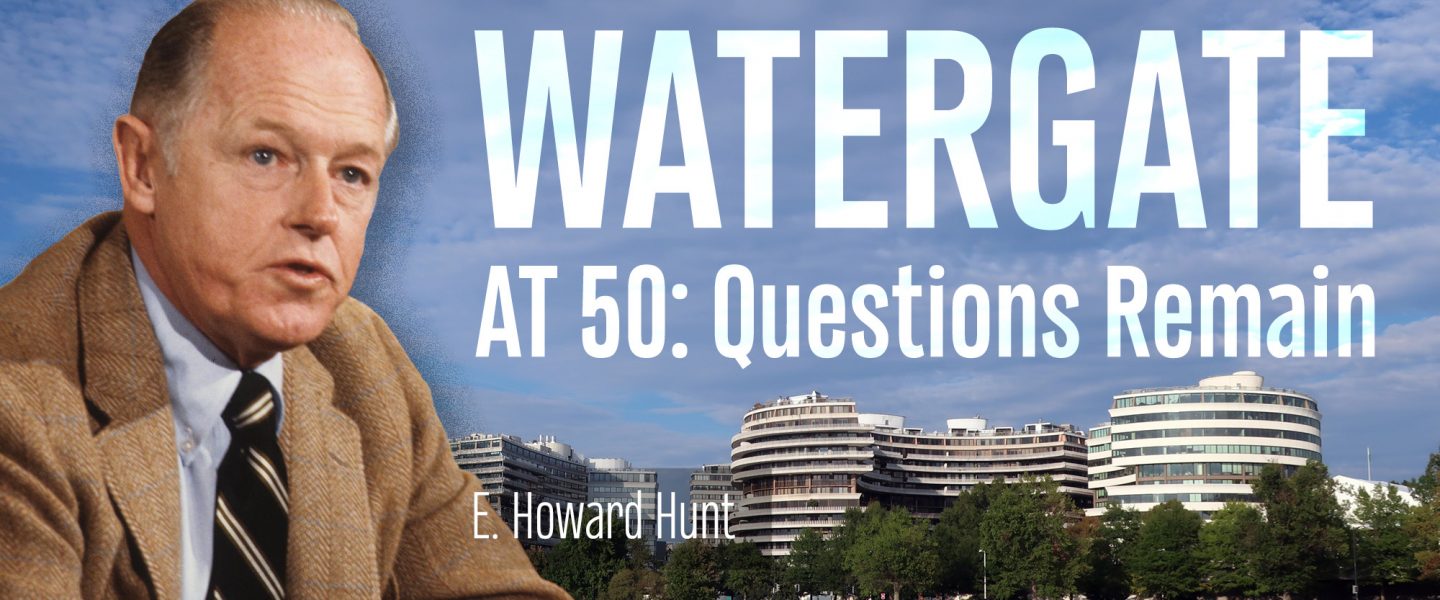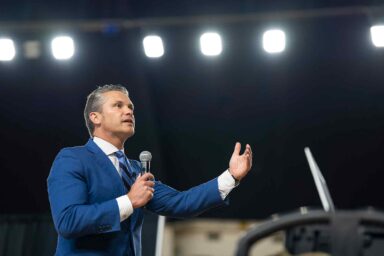Fifty years after the Watergate arrests, the open-and-shut case remains a mystery wrapped in an enigma.
Having written a book about Watergate that questions The Washington Post’s blinkered narrative, I have become a kind of lint-trap for inquiries from readers who ask, “It’s 50 years later and… what don’t we know? Isn’t everything known by now?”
It’s a curious question because the answers depend upon who’s asking. For instance: Thanks to the Post, the CIA, and the Senate Select Committee that investigated the affair, the public still doesn’t know who sent the burglars into the Watergate on the night of June 17, 1972. Was it John Dean or Jeb Magruder? (Whatever.) What were they actually looking for? What did they hope to find?
Howard Hunt told his anti-Castro cohort from Miami that they were to look for evidence that Cuba was secretly contributing to George McGovern’s presidential campaign. But there was never any evidence of that, nor any reason to think that there might be. In reality, Hunt’s instruction was an excuse for the break-in. But it wasn’t the reason for it.
Then what about Howard Hughes? He’d embarrassed Nixon years earlier and, since then, Hughes had hired Larry O’Brien to handle his Washington affairs. O’Brien was a Kennedy Democrat who soon afterwards became chairman of the Democratic National Committee (DNC). Might not O’Brien’s office have been the target?
With John Dean at his side, Gordon Liddy had targeted O’Brien in conferences with then Attorney General John Mitchell — only to have Mitchell scoff at the idea. As Mitchell told me, “The DNC was a ceremonial institution. It had no intelligence value whatsoever.”
Even more to the point: O’Brien had moved to Florida weeks before the break-in and would not return to Washington for months. Bugging his telephone — or his office — would have been useless. He was literally never there.
Gordon Liddy was the burglary team’s ostensible mastermind, and in his view, its mission was counterintelligence. That is to say, the burglars were to look for information that the Democrats might have that would endanger President Nixon’s re-election. He held to that view during his many years in prison, then changed his mind when he faced up to the realization that he’d been a dupe. In the end, he decided that the break-in was ordered by Dean to acquire intel about a liaison arrangement between the DNC and a call-girl operation at the nearby Columbia Plaza Apartments. As evidence, Liddy referenced a key that was wrested from one of the burglars.
This was Eugenio Martinez, a Cuban spook on the CIA’s payroll when he was arrested. Martinez refused to say how or from whom he got the key, which the FBI determined fit the desk of a DNC secretary named Maxie Wells. Questioned about the key, she insisted that there was nothing in her desk that could be of interest to anyone. It was just “pencils and paper-clips.”

Though the key was the only physical evidence that spoke directly to the burglary’s target, and thereby to its purpose and intent, the “key to the break-in” has yet to be reported upon by the Post or its loyalists.
Whatever the purpose of the break-in and attendant electronic eavesdropping operations, the modus operandi of the team’s leader, James McCord, generates a host of questions. Chief among them: what was he thinking? The eavesdropping scheme was clearly designed to fail.
Monitoring calls in the “listening post” at the Howard Johnson’s motel across the street from the DNC was a former FBI agent named Alfred Baldwin. An employee of McCord’s, it was Baldwin’s job to monitor both the bug that McCord said he had installed in O’Brien’s office, and a second bugging device that McCord claimed to have put on a telephone in the mostly vacant office of Spencer Oliver Jr. (Maxie Wells’s boss).
The blatant incompetence of the eavesdropping operation generates a host of questions posed by those who would understand it. How was Baldwin, working alone, supposed to monitor two bugs at the same time? A voice-actuated tape recorder would have solved the problem — and Baldwin had one close at hand. But there was no way to hook it up to the receiver he was monitoring because McCord didn’t have any speaker wire. In other words, “the dog had eaten his homework.” (Speaker wire was about as hard to find as soap or milk. Circuit City and Radio Shack stores were everywhere and had bales of it.)
Without a voice-actuated recorder, Baldwin was virtually chained to his desk, making handwritten notes on a yellow legal pad, memorializing literally hundreds of telephone calls that he listened in to in the days before the Watergate arrests. Even then, the eavesdropping exercise was at best slipshod. Under the circumstances, Baldwin could only listen to some of the calls. If he got up to go to the bathroom, to walk around the block or go elsewhere to eat, he risked missing an important call. Not that there were any. Liddy was infuriated by the insipid content of the calls, and by the amateurish way in which Baldwin prepared his so-called “transcripts.” (Compounding Liddy’s anger was McCord’s insistence that he “edit” Baldwin’s notes before turning them over to the operation’s supposed commander.)
So, when people ask about “the tapes” that Baldwin made, they’re surprised — even skeptical — to learn that there weren’t any.
What was going on? Surely, this was the most amateurish and self-sabotaging operation in the annals of electronic eavesdropping. It was literally designed to be useless. But the man who designed it — Jim McCord — was a career CIA officer who’d served for years at the highest level of the Agency’s inner-sanctum, the Office of Security. Legendary CIA Director Allen Dulles called McCord “my top man.” And CIA Counterintelligence Chief Jim Angleton agreed. “McCord wasn’t just a security man. He was an operator. And a damned good one.”

Anything having to do with McCord’s role in the Watergate break-in evokes a litany of questions. But the answers are harder to come by — and this, because the June 17 break-in simply wasn’t much investigated.
Five men had been arrested after midnight in the national headquarters of the Democratic Party. They had cameras and bugging devices ready to be deployed, and the team’s leader was a spook who happened to be the security director of the Republicans’ Committee to Re-Elect the President.
So it seemed to be “an open and shut case.” And that’s reflected in the Final Report of the Senate Select Committee on Presidential Campaign Activities. After months of hearings in the run up to President Nixon’s resignation, the report numbered a whopping 1,229 pages. A door-stopper. But only two of those pages — two — dealt with the actual break-in.
Had any of the Committee’s investigators actually taken the time to walk through the Watergate office building, perhaps in the company of Royce Lea, Watergate’s maintenance supervisor, they would have realized that something was amiss. The burglars’ accounts beggared belief.
One person who did walk through the Watergate with Lea was Bob Fink, a researcher who worked with Woodward on All the President’s Men.
As Fink recalled, “Lea’s been with the building since the concrete was poured. He’s a guy who takes pride in knowing every electrical outlet, every light socket in the entire complex.
“It’s funny,” he said. “We crawled through the building, tracing the supposed movements of the burglars, and it was obvious that the break-ins couldn’t have happened the way McCord and the others said. They’d have had to walk through concrete walls, and go through doors where there were no doors. But despite all the investigations, and the millions of words that were written, as far as Lea knew, no one — not the police, the prosecutors or the reporters — had actually walked through the place the way we did.” Had they done so, they would also have learned that an amusing story Hunt tells about being stranded all night after a pretext banquet in the Continental Room was false.

The story was meant to explain the disappearance of Hunt and his Cuban locksmith, Virgilio Gonzalez, after a dinner-for-eight in the Continental Room at the Watergate. The gathering occurred over the Memorial Day weekend and was meant to pave the way for Hunt and Gonzalez to breach the DNC later that evening. But the plan was thwarted at 11 p.m. by a motion-activated alarm in the corridor outside the Continental Room. As a result, Hunt and Gonzalez were stranded with the dirty dishes until the following morning. Or so Hunt claimed. But there was never an alarm in that corridor, nor anything that could have been mistaken for one. Fink recalled that Lea “showed me how the door was unencumbered by an alarm, and categorically stated that if there was ever an alarm on the door, he’d have known when it was installed and when it was removed. In fact, he’d have a work order on file in his office but, of course, there isn’t one because there wasn’t any alarm.”
Which adds yet another entry to the long list of Watergate’s Known Unknowns: What were Hunt and Gonzalez actually doing that night? And another: Why didn’t Woodward and the Post follow up on Fink’s walk-through with Lea? Why were so many determined to overlook so much evidence? Did they have “a need not to know?
The truth is: McCord had the run of the place. For example, at 12:30 a.m. on Sunday morning, May 28, McCord led six of his cohort and launched what they hoped would be the first successful break-in to the DNC. Dressed in business suits, they walked up to the security-desk and, using aliases, signed into the visitors log, indicating that their destination was the Federal Reserve Board (FRB) offices on the eighth floor.
The guard on duty appears to have been Frank Wills, and if he had any questions for McCord’s task force, they have not been recorded. Which is odd, inasmuch as the FRB had been burglarized earlier that same month and the security was supposed to have been on alert.
Eugenio Martinez (aka “Muscalito”) recalled: “All seven of us in McCord’s army walked up to the Watergate complex at midnight. McCord rang the bell, and a policeman came and let us in. We all signed the book, and McCord told the man we were going to the Federal Reserve office on the eighth floor. It all seemed funny to me. Eight men going to work at midnight. Imagine, we sat there talking to the police. Then we went up to the eighth floor, walked down to the sixth — and do you believe it, we couldn’t open that door [to the DNC], and we had to cancel that operation.
“I don’t believe it has ever been told before, but all the time while we were working on the door, McCord would be going to the eighth floor. It’s still a mystery to me what he was doing there. At 2 a.m. I went up to tell him about our problems, and there I saw him talking to two guards. What happened? I thought. Have we been caught? No, he knew the guards. So I did not ask questions, but I thought maybe McCord was working there. It was the only thing that made sense.”
That McCord knew the Watergate guards by name was unsurprising. One of the people who worked for him — apparently unbeknownst to the others — had recently worked at General Security Services, Inc., which had the contract to guard the Watergate. This was Lou Russell, a Runyonesque private eye and undercover Everyman who, as it happened, hated President Nixon — so much so that in the aftermath of the Watergate arrests, Russell switched sides and went to work for the Democrats. McCord’s infamous letter to the Ervin Committee, charging that bribery and perjury were afoot, was followed soon afterwards by McCord taking Russell’s urgent advice that he fire his first attorney (who intended to mount “a CIA defense” for his client, in order to retain Bud Fensterwald. Well-known in Washington as the founder of the Committee to Investigate Assassinations (JFK, RFK, MLK), Fensterwald was yet another of Russell’s employers. Together, they told anyone who would listen, “We’re going after the president.”
So it was that the Watergate scandal arrived at its final destination: “Regime change.”
Which brings us to what used to be called “the $64,000 question.” Was regime change the goal from the affair’s inception, or was it an unintended consequence that the Democrats and others seized upon? To put the question another way, did McCord sabotage the Watergate break-ins to rid the White House of President Nixon or, as seems more likely, did he do so to protect a domestic CIA operation at the DNC? And if the latter, what was the purpose of that operation?
Jim Hougan is a former Washington editor of Harper’s Magazine, and the author of Secret Agenda: Watergate, Deep Throat, and the CIA, and Spooks: The Haunting of America —The Private Use of Secret Agents. Writing with his wife under the pseudonym “John Case,” he is the author of seven novels, including The Genesis Code and Kingdom Come. Some of Hougan’s investigative pieces can be read on his website, Jimhougan.com.



